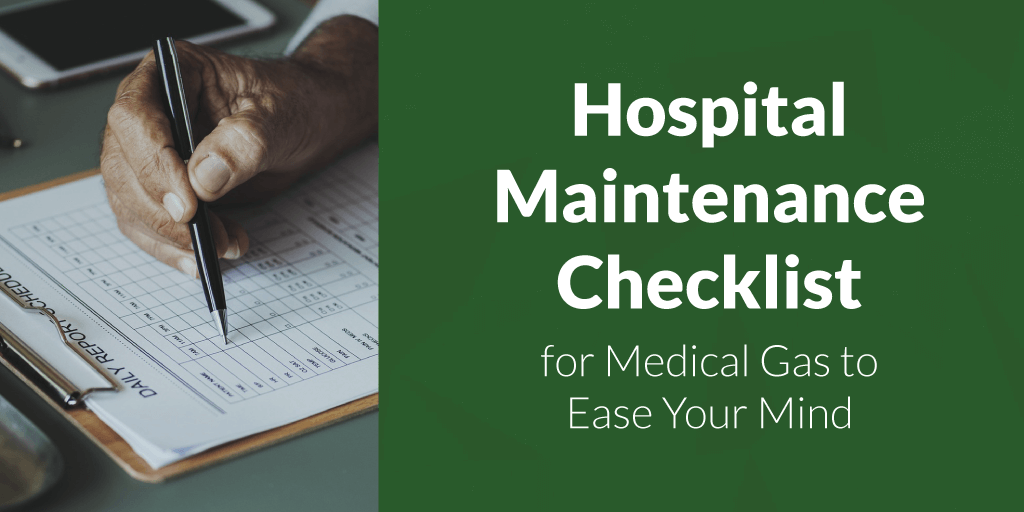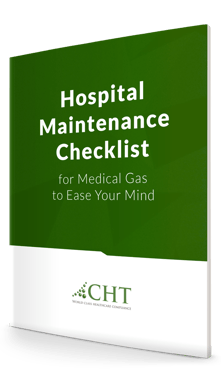
Medical gas systems are a standard feature of most healthcare facilities, and they require special monitoring and maintenance to ensure they are operating properly.
Unlike other medical equipment and systems, their use of gas under pressure makes them vulnerable to a unique set of unexpected failures, which may not be readily apparent.
This makes medical gas preventative maintenance critical to a problem-free working environment.
At CHT, we understand you want your medical gas systems to be compliant, pass inspection, and, most of all, increase patient safety. We understand it's crucial to keep your medical gas systems running smoothly so you have no unexpected failures and you have the proper equipment to do your job competently and worry-free.
We are dedicated to making sure your hospital and your patients are getting all they need from your medical gas equipment. We put together a preventative checklist to help prepare you for an upcoming inspection and to alleviate your concerns and frustrations.

According to NFPA code (5.1.15), all medical gas and vacuum systems need to have a routine maintenance program.
What does a routine maintenance program mean?
It means a program that puts patient safety first, which is always a top priority. A routine maintenance program helps healthcare facilities prepare for any survey process, ongoing maintenance, and repairs that will mitigate failures.
Top Medical Gas System Maintenance Questions [We Can Help You Answer]

1. When Was the Last Time Your System Was Inspected?
Healthcare facilities need timely inspections for piping, outlets/inlets, valves, flex connections, alarms, and source equipment. A successful survey requires operational, maintenance, and repair information on hand.
2. Are You Concerned That You Are Not Receiving Proper Flow or Pressure in Your Medical Gas System?
National statistics show that the average minute spent in the operating room costs $72. Having improper suction in the operating room is a problem, both in terms of cost and safety, because it means the removal of liquids, solids, and waste gases may take longer than necessary.
This is because an ideal flow rate may not be reached due to poor suction.
3. Are You Concerned About a Possible Leak in Your Medical Gas Equipment?
Low suction or vacuum may indicate a leak in the system and may result in excess operational costs. An adequate vacuum at the wall in the operating room is needed to allow the physician to titrate the exact level needed for the task at hand.
A leak in a medical gas system in the hospital environment is a problem in terms of quality, cost due to material losses, and also one of safety.
There can be an ongoing avoidable cost regarding gas waste and/or overly frequent cylinder replacement. A facility may encounter more severe cost implications if a poorly functioning system leads to source equipment failure or longer procedure times.
The best approach, whether in a small clinic or a large hospital network, is to establish a comprehensive medical gas preventative maintenance program to identify and avert these problems as soon as they arise.
4. Are You Aware of the Most Current NFPA Codes on Required Maintenance?
NFPA 99 2018, 5.1.14.2.2.5 states credentialing to the requirements of ASSE 6040 and ASSE 6030 are required qualifications.
Code 5.1.14.2.2.4: "Scheduled maintenance for equipment and procedures shall be established through the risk assessment of the facility and developed with consideration of the original equipment manufacturer recommendations and other recommendations as required by the authority having jurisdiction."
Code 5.1.14.2.3.1: "Nonstationary booms and articulating assemblies, other than head walls utilizing flexible connectors, shall be tested for leaks, per manufacturer's recommendations, every 18 months or at a duration as determined by a risk assessment."
5. Do You Know the Original Equipment Manufacturer Recommendations for Each Component in the Medical Gas System?
When creating a routine maintenance program, you should reference the equipment manufacturer's recommendations.
Different items need to be checked daily, weekly, monthly, or annually based on the equipment and sub-equipment requirements.
Maintenance of medical gas equipment cannot be overlooked or ignored, despite the technologies employed or the frequency of use. Equipment performance is directly connected to patient care and patient and employee safety.
6. Was Your System Inspected & Tested by a Qualified Individual?
Compliance requires that all inspections, testing, and maintenance are conducted by qualified personnel.
Verification is required for any new installations, additions, or renovations.
To become an ASSE 6030 Verifier, an individual must have at least two years of documented practical experience in the verification of medical gas systems, as well as completion of a minimum 32-hour training course instructed by an ASSE 6050 instructor.
Persons maintaining systems shall demonstrate appropriate qualifications by attaining their ASSE 6040 Maintenance Personnel qualification, 6030 qualification, or by completing a documented training program acceptable to the facility.
7. Do You Manage Medical Gas Repairs and Maintenance With a Computerized Monitoring Solution?
The best approach is to have a computerized monitoring solution that monitors the whole system, from the gas source through the piping and finally to the patient.
A fully-featured software program provides the ability to map out the entirety of your piped gas system, with individual components barcoded for easy identification and replacement if necessary.
You ideally want a software solution that allows you to access information on required medical gas preventative maintenance from multiple computer stations.
8. Are You Aware of All Your Medical Gas Equipment That Does Not Use Oil?
Hospitals often believe that equipment that uses little or no oil does not require a maintenance plan because there is no oil to replace or check.
This is incorrect and can lead to malfunctioning equipment.
All life safety equipment has to be cycled regularly to ensure it will work as required.
Also, equipment that uses no oil still requires an in-depth maintenance program. When overlooked or ignored, the equipment will wear down and fail to operate. This applies not only to equipment that is seldom used but also to equipment that is used on a daily or hourly basis.
9. Do You Properly Monitor Your Central Supply Systems?
The medical gas source equipment used will vary, depending on the type of gas and the size of the institution. For smaller needs, cylinder-only solutions are often adequate.
For large hospitals with substantial requirements, cryogenic liquid systems may be utilized to provide piped gas.
Compressors are also used to provide medical air and vacuum pumps are needed for suction.
Failing to properly monitor these complex pressurized systems can be costly, both in terms of increased use of consumables and damage to permanent equipment.
Preventative Maintenance Checklist for a Pump or Compressor

Preventative Maintenance means inspecting, testing, and updating source equipment that supplies the array of gases used in the hospital: Medical Air, Nitrous Oxide, Carbon Dioxide, Medical-Surgical Vacuum, and Waste Anesthesia Gas Disposal (WAGD).
PM means checking the components of each supply system to verify their proper operation and inspection of the machines' parts for wear or obstruction.
- Every pump or compressor has an hour meter that shows how much it has been used. All medical gas source equipment shall be redundant: that is, the primary supply that has a companion, perhaps duplexed or multiplexed, that is always on standby in the event the primary pump fails or is unable to keep up with demand. Regular alteration of components is vital. The length of run time prescribes oil changes and other checks of critical components.
- Filters are checked and often replaced to make sure the output meets applicable standards.
- Belts and mechanical connections between the drive system and the pump or compressor are checked to verify they are working well and to detect labored operation of the pump.
- If oil is used, it is checked for condition and level. Oil use indicates worn parts inside the pump.
- Drains are checked to verify free flow and proper operation. As air is compressed, it “wrings” the humidity out of the air, and this water must have a clear path to the drain, or it can back up into the compressor itself.
- The voltage and amperage of the running pump are checked to verify it is operating to the manufacturer’s specifications. An electrical motor pulling more than the specified electricity signals worn internal components and labored operation.
- Audible and visual indicators are checked to verify they provide a signal when they should and will signal when a default condition exists.
- Alarms are tested to ensure proper set points.
- Operating temperature is monitored, and the high-temperature shut-off is activated to avoid burning out a pump or compressor.
- Valves and rings are checked in reciprocating compressors.
- The actual dew point (or the amount of water in the output) is measured and compared to the set values of the dew point alarm. Some water in the air makes breathing easier for patients, but too much can clog lines, equipment, and labor breathing.
- The room condition is noted as well. There should be regular airflow to the external ventilation to prevent overheating.
Conclusion
To ensure patient and staff safety, hospitals need ways to confirm that all the equipment and devices that affect life safety are working to spec and reliable.
Managing your medical gas equipment with risk assessment or preventative maintenance program can end up being complicated. Working with a team of medical gas professionals can alleviate the worries that your equipment may malfunction or become non-compliant, resulting in costly fines, repairs, or replacement.
CHT provides innovative technology solutions to help you control, manage, and monitor your medical gas system, the environment in your treatment areas, and the efficiency of your ORs.
Our certified staff can come to your facility and make a detailed inspection that will help you stay The Joint Commission and CMS compliant.
When irregularities or deficiencies are identified, CHT can close the loop, providing ASSE-certified technicians to replace and repair outlets, pumps, lines, and alarms.
Consult with your CHT representative to have the confidence you will pass your next survey with all the proper documentation.




